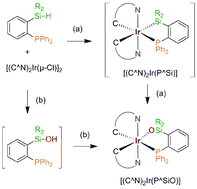Phosphorescent Ir(iii) complexes with both cyclometalate chromophores and phosphine-silanolate ancillary: concurrent conversion of organosilane to silanolate†
Abstract
Ir(III) metal complexes with general formula [(C^N)2Ir(P^SiO)], where (C^N)H is

* Corresponding authors
a
Department of Chemistry, Tsinghua University, Beijing 100084, China
E-mail:
zhangfs@mail.tsinghua.edu.cn
b
Department of Chemistry, National Tsing Hua University, Hsinchu 30013, Taiwan
E-mail:
ychi@mx.nthu.edu.tw
Tel: +886 3 5712956
c
Institute of Optoelectronic Sciences, National Taiwan Ocean University, Keelung 202, Taiwan
E-mail:
wenhung@mail.ntou.edu.tw
d
Department of Chemistry, National Taiwan University, Taipei 10617, Taiwan
E-mail:
chop@ntu.edu.tw
Ir(III) metal complexes with general formula [(C^N)2Ir(P^SiO)], where (C^N)H is

 Please wait while we load your content...
Something went wrong. Try again?
Please wait while we load your content...
Something went wrong. Try again?
F. Zhang, L. Wang, S. Chang, K. Huang, Y. Chi, W. Hung, C. Chen, G. Lee and P. Chou, Dalton Trans., 2013, 42, 7111 DOI: 10.1039/C3DT32408G
To request permission to reproduce material from this article, please go to the Copyright Clearance Center request page.
If you are an author contributing to an RSC publication, you do not need to request permission provided correct acknowledgement is given.
If you are the author of this article, you do not need to request permission to reproduce figures and diagrams provided correct acknowledgement is given. If you want to reproduce the whole article in a third-party publication (excluding your thesis/dissertation for which permission is not required) please go to the Copyright Clearance Center request page.
Read more about how to correctly acknowledge RSC content.
 Fetching data from CrossRef.
Fetching data from CrossRef.
This may take some time to load.
Loading related content
